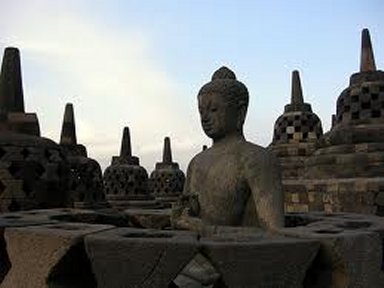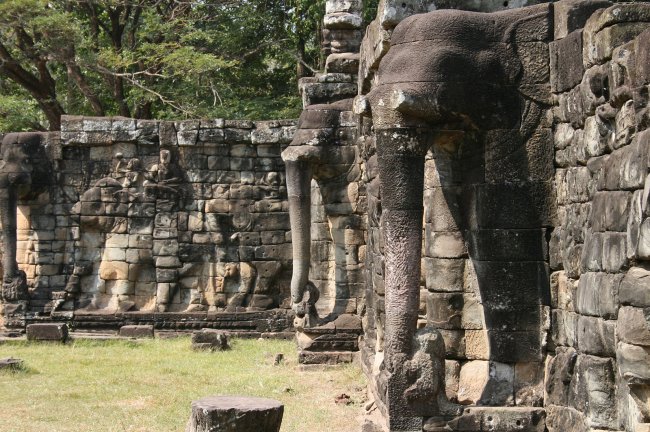
First and Only Weekly Online Fanzine Devoted to the Life and Works of Edgar Rice Burroughs
Since 1996 ~ Over 10,000 Webpages and Webzines in Archive
Volume 3350
The Jungle Girl
by
Edgar Rice Burroughs
A Review by R.E. Prindle
![]()

Borobudur In Bali

A Review by R.E. Prindle
![]()

Borobudur In Bali
This lovely little fairytale was written over October to December of 1929. Its magazine publication was in Blue Book, October 1930 to April 1931; book publication was in 1932.ERB published three books with 'Girl' in the title and all three were published at very critical junctures in his life and portray the heroine in three different lights. The first of these written over 1913 and 1914 was The Girl From Farris’s. In this novel the Girl is held prisoner in the house of ill fame of Farris, escaping she is still virtuous but tainted by association. In other words, who’s going to believe her.
Idealized ApsaraOriginally the novel was titled The Girl From Harris's but as one Harris did run a noted brothel it was perhaps thought better to change the H to an F. The story recounts ERB’s life from Toronto to his accession to fame and success in 1914 which he found a little bewildering. Ultimately the hero's life, Ogden Secord, is redeemed and the Girl's reputation restored.
The second novel, The Girl From Hollywood, takes place as ERB’s financial follies have placed him between a rock and a hard place. Hence his heroine is corrupted by Hollywood bringing her to ruin. A touch and go time that affected the rest of Burroughs’ life.
The third novel, The Jungle Girl, alternatively published as The Land Of Hidden Men, is a pleasant fairy tale of The Sleeping Beauty order where after passing through a forest of thorns the Prince kisses the Beauty awake and they live happily ever after. It would seem obvious that the story is about Florence and ERB.
The tale was written in 1929, not published in magazine form until 1931 and finally in book form in 1932. These were tumultuous years for ERB. To speak authoritatively it would be necessary to compare the magazine version to the book for any last minute changes to reflect his current situation. I haven’t done that.
Real Apsaras
By 1929 ERB’s romance with Florence was well advanced. He may indeed have thought he had found his fairy queen. I would imagine that Emma was well aware of the relationship by this time. Then Trader Horn was released as a best selling book being made into a blockbuster movie by MGM in 1930. This whetted their appetite for further African adventures and they alighted on Tarzan Of The Apes. In the Spring of 1931 ERB assigned the movie rights to to his birthright to MGM for a mess of pottage, five Packard automobiles. By the time Jungle Girl was published in 1932 the first MGM Tarzan had been released with seller's remorse settling in on Burroughs. He no longer had control of his character. He wasn’t happy with what he'd done. In the light of that folly Jungle Girl takes on a bitter-sweet quality. For that reason it would be nice to compare the magazine and book versions.
The story, while not particulary noteworthy has a certain charm. ERB places the story in the jungles of South East Asia among the Khmer ruins. He had either read a book on the Khmers and the ruins of their cities and temples in the jungles of Camboida, Siam and Viet Nam or perhaps an article or two in the National Geographic because the story follows the history reasonably closely. Enough so that his story was virtually written for him.
ERB's hero is named Gordon King. This is probably an amalgam of the British general, Chinese Gordon and ERB’s old hero General Charles King from the Michigan Military Academy. Gordon may have been suggested by the proximity of China while King was still clinging to life dieing in 1933 while representing happier memories.
ERB’s character Gordon King is also a physician, an important detail to bear in mind. In the story King is approaching the Khmer lands from the Mekong River in Viet Nam. As the story opens on the edge of the jungle King's guide will go no further. He advises King that if he enters the jungle he will never come out again as no who enters ever returns. Of course King disregards the advice. Thus he is at the point of no return. Perhaps this signifies what were several turning points in ERB’s life at the time. Originally it may have signified his taking Florence and leaving Emma as King finds his soul mate in the jungles and indeed, never returns. ‘Did he ever return? No, he never returned and his fate is still unlearned.’ Then in 1931-32 it may also signify the loss of Tarzan to MGM and a sort of distancing from reality in his mind, a sort of madness. To enter the jungle is to pass the bounds of sanity into a another mental realm.
At any rate in the jungles the ancient Khmers still reign. Great cities identical to Angkor Thom and temples like Angkor Wat are still fresh and new not overgrown with mighty tree roots and vines.
King pays for his hubris by getting lost even after taking the most meticulous precautions except for blazing a trail. We all make one mistake. As Burroughs characters always do one is led to believe that ERB has a psychological repetition compulsion to make that one mistake. Possibly it indicates that in relation to MGM ERB himself had lost his way and to some extent his future.
King becomes injured and in a fairy tale fashion he is nursed to health by a poor peasant couple living far from the haunts of men. Before being saved King in his feverish delirium sees a group of ancient Khmer warriors conducting a beauteous maiden through the jungle on an elephant. When he recovers he learns it was not delirium but a fact.
Then one day while hunting King is captured and taken to the city of Lodidvarman. There he finds his soul mate as a slave of Lodidvarman as a lowly dancing girl or apsara. ERB likes the word apsara because he uses it a lot. He has apparently taken the plural for the singular which he then pluralizes into apsarases.
In true fairy tale fashion King will have to perform a seeming miracle to win the apsara who has attracted the eye of Lodidvarman. The king is known as a leper because he is covered with sores. He is also addicted to eating mushrooms which is a broad clue to the denouement. Through a series of adventures involving appropriately a giant, King escapes with the apsara only to be recaptured, but not before arranging to return the apsara to her own rival kingdom where she is no slave girl but in fact the Princess. The rival kingdom vaguely resembles the historical situation between the Khmers and the Thais.
The princess is to be compelled to wed the evil premier of her father. By this time she is entranced by Gordon King and wants no other.
Waiting in a prison cell in Lodidvarman’s castle King is about to be put to death treacherously when he has a brainstorm. As a physician he believes he knows the nature of Lodidvarman’s disease and it isn’t leprosy. It’s those mushrooms. The king has an allergic reaction to the mushrooms which have been his sole diet for years.
Of course King doesn’t let out his secret but as part of his regimen requires the king to abstain from his mushrooms. Within three weeks the king is blemish free and King is a Prince. Life in the jungle ain’t so bad.
Now the Thais attack the Khmers. Great armies of men and elephants clash. The Thai line is broken. The Thai king is treacerously stabbed by his premier. King rescues that king then races to the Thai capitol to rescue his dancing girl. In a scene reminiscent of the wedding scene in Chessmen of Mars he does so. The new Prince now discovers that his slave dancing girl or apsara is in reality a Princess. They had each met each without knowing the real status of the other so they are secure in knowing that each is loved for him or herself. ERB may have some doubts as to Florence’s attraction to himself.

Anghor ThomTaking the Princess to where he had hidden the dieing Thai king the king blesses the union. With the blessing King is able to accept the Thai throne thereby becoming a king in more than name only, king King. One guesses that by King becoming a king Burroughs is able to regain his self-esteem after losing Tarzan to MGM. He and his queen live happily ever after. King the king indeed never returns from the jungle. If he were alive he’d be out there yet.
It may be possible to compare the jungle of the great stone cities to Opar. In 1930's Tarzan The Invincible Stalin and the Communists had destroyed Opar as a psychological refuge for Burroughs. Under great stress from 1929 to 1932 the land of the Khmers gave him a psychological refuge that no one else could enter while providing a place he would never have to leave. Thus a sort of madness or dissociation from reality. So long as he had money he could pretend he was the charmed and charming Prince with his dream Princess. Perhaps not having money contributed to his breaking up with Florence when they were living on 250.00 a month in Hawaii.
Unfortunately in real life Florence wasn’t the dream Princess he thought she would be. After a few troubling years he abandoned her returning to the bachelorhood he wished he’d never left.
While this is not one of his great stories it is one ERB's most pleasant, soporific even, like some narcotic. It also forms a trilogy with The Girl From Farris's and The Girl From Hollywood while in its way forming a conclusion to the four Opar novels. As one studies Burroughs novels one finds wheels within wheels.
WEB REF
Guide
to Thailand: Khmers
R. E. Prindle welcomes your comments
at:
dugwarbaby@yahoo.com
![]()
|
and Follow the Navigation Chart for the Entire Series of Articles |
|
Differing viewpoints are welcome. |
|
are not necessarily those held by Edgar Rice Burroughs, Inc. |
